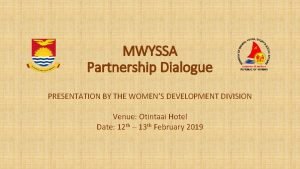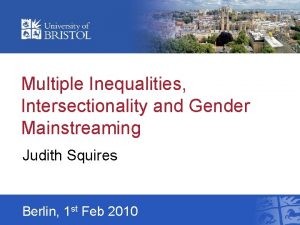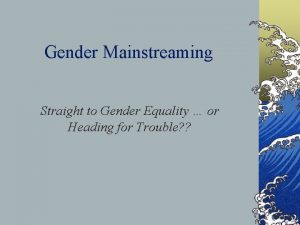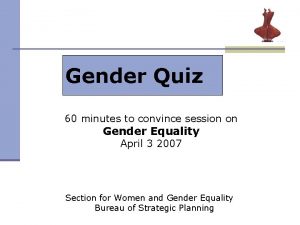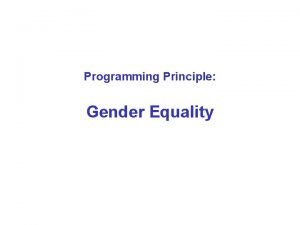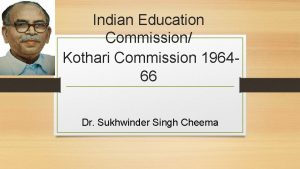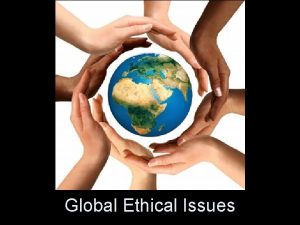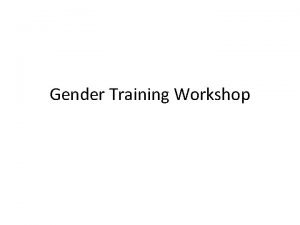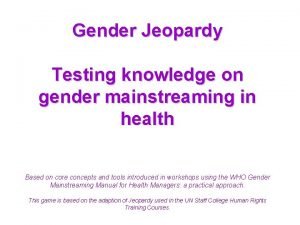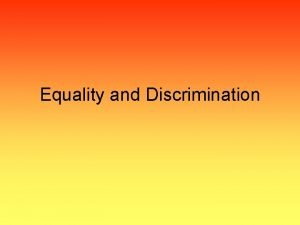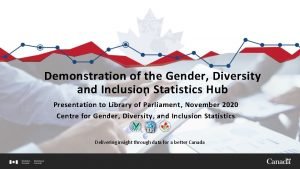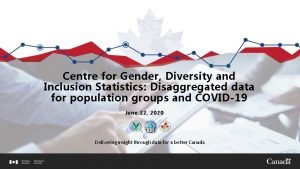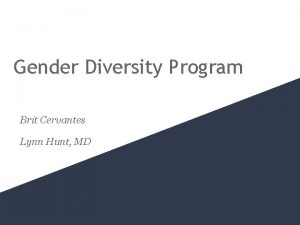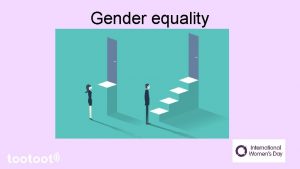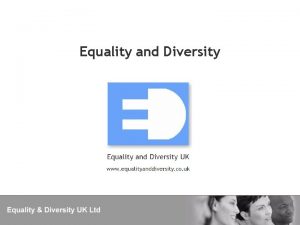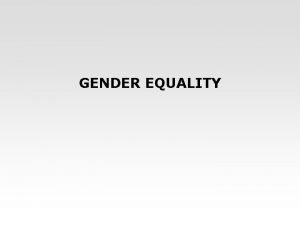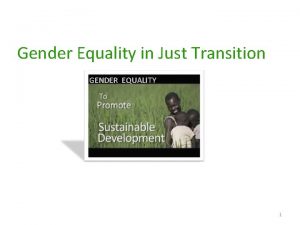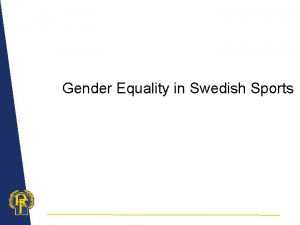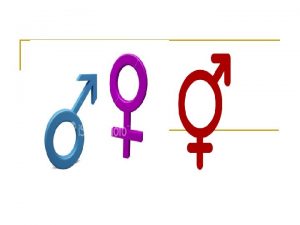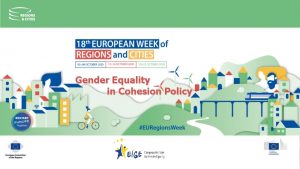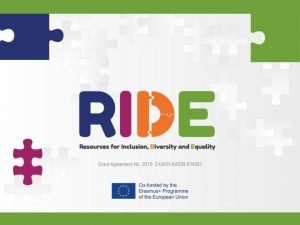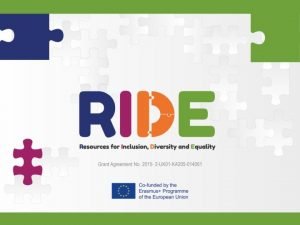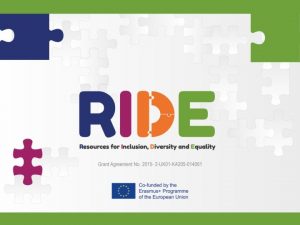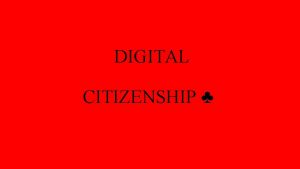Postnational challenges to Citizenship Research Gender Equality Diversity
















- Slides: 16

Post-national challenges to Citizenship Research: Gender Equality, Diversity & National belongings Birte Siim, Aalborg University Beyond Citizenship: Feminism and the Transformation of Belonging, London 30 June – 2 July, 2010

The post-national challenge to move beyond the nation state § Cosmopolitan citizenship: Add human rights to citizenship rights & global governance to tackle poverty, inequality, the environment (Linklater) § Transnational identities & translocal loyalities: EU, transnat. civil society, transborder migration networks, global solidarity § EU - a test case for approaches pro and against expanding rights, responsibilities and belonging beyond the nation state

Gendering European Citizenship Critique of the EP models (U. Liebert): 1. The liberal market model is exclusionary 2. The republican citizenship model – is homogenizing 3. The cosmopolitan model – is built ’from above’ 4. Only the deliberative model is able empower women as social & political actors

Democratic citizenship: Diversity in the Public Sphere Dimensions of the public sphere, Ferree 2002: 1. Who should participate, on what occations? 2. What should be the form of content of their contribution to the public discourse? 3. How should the actors communicate with one another? 4. What are the desired outcome of the process?

Eurosphere: Diversity and the EPS http: //www. eurosphere. uib. no/ § What are social & pol. actors views about diversity & EPS? What models do organizations believe in - a centralized or fragmented (or another model of) European Polity? Organizations’ views on EU polity/policies: views on the development of EU-polity; and views concerning EU's involvement and power in policy-making § Do actors/organizations communicate/ participate in EURO-networks spaces? § What are their perceptions of diversity, PS & EPS

Methodological Reflections § Multi-level model – macro-meso & micro § Multiple approaches to the EPS § Comparative approach: 16 countries, 200 organisations, 1300 interviews § Multiple sites: Political parties, social movements/NGOs, think tanks, and media § Data: Elite interviews, institutional data, media and surveys § Methods: Content analysis, critical frame analysis and discourse analysis of texts

Research Questions and Dimensions § § Where are the women - presence, voice & power/empowerment- who participates? Gendering as a process – framings, arguments & discourse, silencing - gender issues as a part of the public discourse? Diversity & pluralism – intersections of gender and diversity - communication? The European Public Sphere (EPS) – outcome, policies and visions for EPS?

Constructions of national and European Belongings Perceptions of DIVERSITY – the Danish case: § Universalist adaptation model – the prevalent model § Particularistic assimilation model – overlaps with the universalist model § Mutual Integration model – a minority model § How do actors link (national) diversity models with EPS models beyond the nation state

Forms of gendering § Where are the women? How are the issues gendered? How are women articulated as bearers of cultural meanings? § Different categories intersect, creating inequality in inclusionary or exclusionary ways (in the political argumentation)

Political Actors Perceptions of Gender and Diversity § The universalist adaptation and particularist assimilation model resembles each other most § The models are based upon ideas of sameness as well as difference § Denmark as a forerunner when it comes to gender equality – to be integrated and be part of the insider group one has to be gender equal § In the Danish national identity construction being equal means being integrated on the labour market

Constructions of identities § Women as gatekeepers/border guards (symbols of belonging/membership): language proficiency (Wodak), gender identity (Yuval-Davis) § Symbolic meaning of gender significant in reproduction of communities: the empowered working woman as border guard of national identity § National/European identity, gender equality and ethnonational diversity intertwined: gender equal, progressive insider vs gender unequal, old-fashioned outsider § Implications for the in/exclusion into national and European spheres of belonging and for the development of Europe as a diverse society § Finding: Young minority women as bearers of integration!

Intersectionality I “I think one should be very careful not to make too general conclusions in this matter because we also see second generation children of immigrants doing great, especially the girls we see at the universities and the schools in Denmark do absolutely marvellous. So, again we should be much more accurate about what we are talking about. Is it the first generation or is it the second generation? The girls are good at finding their way into our educational system but the boys are, so to speak, hopelessly maladjusted and they find some subcultures which are hopeless to deal with. ” § (IP, Danish, Social Democrat) § Intersection of generation, age, ethnicity and gender § Creation of category of belonging and membership: who is defined as the European woman § Belonging – integration – gender equality – labour market participation

The ’includer’ “I become extremely happy when I see some of these immigrant girls, who are the ones that manage the best, who just develop very fast and also handle having a good relationship with their parents who are proud of them, naturally, but who also think that they do a lot of things wrong. […] Just as somebody like me, coming from [a marginal region in Denmark], coming from such an Inner Mission environment. I mean, most people do not live the same life as their parents and do not share the same values either. […] It is something you have to be able to handle as a human being”. (IP, Socialist People’s Party)

The ’excluder’ “Since for instance many Muslims come with a Middle Age world view in terms of women, then [gender equality and diversity] is a problem but I actually always think that, well, the thing about gender equality, I think, we are really on the way to achieving it without… if we do not consider the ethnic groups, then we are well on our way to a reasonable gender equality. In relation to this, it puzzles me that these women’s movements do not touch the other thing even though it ought to be their first objective to get many of these Muslim women out of these slave-like relations they are in. I remember in the 60’s how they stood and shouted, the women’s movements, outside schools where meetings in the housewife association were held. And, back then, I thought that was a bit ridiculous. I still think it is. But it shows how strong feelings there were […]. And then there are no feelings at all when it comes to what is going on right in front of us”. (IP, Danish People’s Party)

Models & Visions for the Public Sphere/EPS § The Pragmatic Approach – the prevalent model across the political spectrum § The Nationalist Model – a counter discourse expressed by DPP & Danish Ass. § The Democratic Participatory Approach – a minority position

Multilayered Citizenship and Politics of Belonging § Social divisions are about macro axis of social power but also involve actual concrete people. Social divisions have organizational, intersubjective, experiental & representational forms…In other words they are expressed in specific institutions and organizations, such as state laws and state agencies, trade unions, voluntary organizations and the family. In addition, they involve specific power and affective relationships between actual people… (Yuval Davis 2006, 198)
 Strategic gender needs and practical gender needs
Strategic gender needs and practical gender needs Gender equality is more than a goal in itself
Gender equality is more than a goal in itself Rhetorical questions about gender equality
Rhetorical questions about gender equality Gender equality definition
Gender equality definition What is gender equality answer
What is gender equality answer Methodology of gender inequality
Methodology of gender inequality D s kothari commission
D s kothari commission Short poem on gender inequality
Short poem on gender inequality Example of gender equality
Example of gender equality Slogan about discrimination
Slogan about discrimination Claudia padovani unipd
Claudia padovani unipd Formal and substantive equality
Formal and substantive equality Cedaw articles
Cedaw articles Centre for gender diversity and inclusion statistics
Centre for gender diversity and inclusion statistics Centre for gender diversity and inclusion statistics
Centre for gender diversity and inclusion statistics Uci gender diversity
Uci gender diversity Ifrc gender and diversity policy
Ifrc gender and diversity policy

